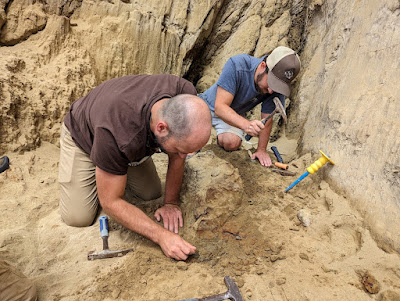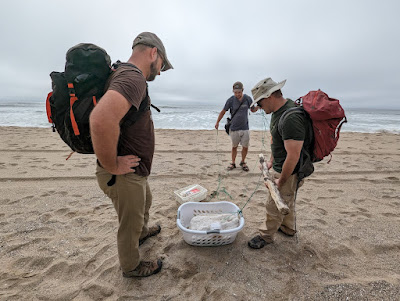Last December I paid a visit to one of my longtime research localities in the Purisima Formation in northern California - one I've been visiting for nearly 20 years now (I found the site in 2004 after getting a tip from a surfer), and have received three permits for collecting. I've published several articles on fossils from this site, and back in 2011 to 2013 published two papers providing an account of the entire marine vertebrate fauna. Since 2013, I've been seeking a permit to return to the locality and was awarded one earlier this year. In December, I was checking up on spots where I had found fossils in the past, and l came across a medium-sized concretion in the base of a cliff. The bone was difficult to see, but the fact that the concretion protruded from the top of the shell bed drew my attention to it. Once I got close, I could clearly see relatively porous bone, complicated structure, and symmetry - when combined with size, these told me that I was looking at a fossil skull. A relatively large skull - about 16 inches wide (~40 cm) - but belonging to one of the smallest baleen whales to ever evolve, Herpetocetus.
The Herpetocetus skull as I first found it - the rock hammer (for scale) is sitting on top of it.
Unfortunately for the completeness of the specimen, the entire rostrum of the specimen as well as the orbits had eroded away. This was partially mediated by the structural geology of the locality: there is a small fault line with an unknown, but likely minor degree of slip here - perhaps calling it a fault is a bit grandiose, but either way, there is a bit of shearing going on here. We are only a mile or so off from the San Gregorio fault, one of the largest faults in the California coast range; as a result, there are loads of more minor fractures paralleling the cliff face with a few millimeters to about 20 cm of offset. In older parts of the section this can result in many parallel fractures spaced a few centimeters apart with some larger fossils fractured like an accordion! I usually leave those behind, but a couple of larger specimens I've collected from that end of the locality have required some challenging preparation as a result. Though less common in the sandier upper parts of the section, a fracture has cleaved the specimen in half and there is a deep sand-filled trench - I suspect there were several parallel fractures in this zone that resulted in weakening of the sandstone, and this zone was blasted out by wave action - including the remainder of our skull.
Explanation of the fossil as discovered in December 2022.
Fortunately for us, this meant that the fossil could be collected in one nice self-contained block that would certainly not exceed 100 lbs (45 kg). This is extremely fortunate, as the specimen was found about a mile from the nearest road! I knew it would take some creativity in physically removing the specimen from the beach. At the time of discovery I wondered how much it would weigh if I just popped the concretion out - I decided against it when I realized that in addition to the skull, there was at least one partial mandible and some ribs, meaning that a somewhat more careful excavation lasting at least a couple hours would be needed. In 2022 when I found this, I was by myself - Chris Pirrone joined me for a half day, but had other obligations. I would not have the help. Certainly, I could have excavated and jacketed the specimen by myself - it would have been a bit of a pain, but it would be doable. However, I would have been unable to move the specimen on my own. Sure, you can always leave a plaster jacket and come back for it another day - that's nearly standard practice in western interior paleontological fieldwork (e.g. Montana, Dakotas, Wyoming, Colorado). But all of those places lack something significant and irritating that I have to deal with: tides. The ocean is great when it's eroding fossils out for you to discover, but it's also dangerous and always trying to kill you and your team and can make life very difficult. As a result of this, I prefer to keep excavations short and remove specimens ASAP. Plaster jackets get blasted away by waves if left until tide cycles and weather catch up. Excavations in the intertidal zone can only last a few hours. We were well up out of the intertidal here, but a jacket would have been buried or blasted away by wave action if left for a few weeks. Plaster is also bright white and attracts attention: this section of beach is remote, but still attracts a few beachgoers and fishermen walking down every day. So, I made the decision to leave the specimen in the field without touching it.
This decision gave me no shortage of anxiety. Two weeks after I left California, an incredible and unprecedented train of spectacular winter storms began hammering the coast. I spent my last semester of teaching here in Charleston with the *worst* case of FOMO ever, watching all of this incredible erosion take place and being unable to check out any of the freshly exposed fossils! And worse, fearing that this little baleen whale skull had eroded away. It wouldn't be until May 2023 that I visited the spot and confirmed that the skull was intact. I was also worried that the skull would be buried by several meters of beach sand.
The distinctive lectotype mandible of Herpetocetus scaldiensis from the Pliocene of Belgium, illustrated by Van Beneden.
Before we continue with the excavation - what's the deal with Herpetocetus, anyway? Herpetocetus scaldiensis was first named in 1872 by Joseph-Pierre Van Beneden, a Belgian paleontologist who named a large number of (occasionally chimaeric) cetaceans from Miocene and Pliocene strata near Antwerp, Belgium. The fossils included a distinctive mandible with a tall joint (condyle) and a long angular process, the combination of which resembled a reptile mandible - hence the name, 'reptile whale'. For years the taxonomy of Herpetocetus was frozen because it became clear that the mandible and other elements such as the tympanic bulla (earbone) were not associated with one another and represented completely different families of mysticetes. Worse, the designation of type specimens had not yet fully caught on and Van Beneden did not select a type specimen. Starting in the 1960s and 1970s more specimens began to be collected in California, Japan, and North Carolina that either consisted of or included mandibles with the same distinctive morphology. Paleontologist and later Nazi Othenio Abel XXX. The long-awaited Lee Creek Mine Volume IV included an entire chapter on Herpetocetus and Nannocetus, written by Frank Whitmore and Larry Barnes in the 1970s and 1980s and submitted in the 1990s. The manuscript and volume were in press (somewhat analogous to 'development hell' in film) for over a decade, but it finally came out. In this study, Whitmore and Barnes (2008) reviewed the material belonging to Herpetocetus scaldiensis and XXX. Chief among these observations was that a skull fragment figured by Van Beneden and likely associated with the mandible included the highly diagnostic squamosal of Herpetocetus, permitting several new skull specimens to be referred to the genus even though they lacked the mandible. These authors also described Herpetocetus transatlanticus, based on a partial braincase from the lower Pliocene Yorktown Formation at the Lee Creek Mine, and Herpetocetus bramblei, based on a fragmentary skull and mandible from the Purisima Formation near Santa Cruz, California! It was good timing for them, because in 2007, I collected about 2/3 of a skull of Herpetocetus from a sandy bed near what would soon be the Herpetocetus bramblei type locality. I would have certainly named it as a new species at the time. I held off study because just when I completed preparation of the specimen, the Whitmore and Barnes (2008) paper had come out - and it was very clearly referable to Herpetocetus bramblei. The timing was further quite good, because just two years later a seawall was built over the entire section of cliffs. This specimen catapulted me down a road studying Herpetocetus and finding many more fossils - and virtually all of this is unpublished still! Now that I'm no longer teaching and my research fellowship has expired, I plan on returning to this research after leaving it for nearly 15 years. It was only a matter of time before I found more Herpetocetus remains.
Comparison of the erosional cross-section through the concretion (flipped upside down) with the CT scan of Herpetocetus bramblei from the Purisima Formation in Santa Cruz, and approximate location of the cross-section based on the reconstruction of Herpetocetus morrowi from the coeval San Diego Formation (from El Adli et al., 2014).
I managed to scrape together a small field crew before leaving for the east coast at the tail end of a vacation - Dr. Ash Poust (San Diego Natural History Museum), Sarah, and our amateur colleague (and friend of the blog) Chris Pirrone helped us. I knew between the four of us we'd be able to get it excavated and transported off the beach, hopefully with time to spare. We spent some time cleaning dust off of it to get our bearings, and then began trenching around it. The concretion stuck a bit further into the rock, but in most places the surrounding sandstone could easily be carved away. Within an hour we had found a couple of bones behind the skull and otherwise had a competent trench around most of it. We started undercutting it, which was surprisingly easy - like a hot knife through butter.
Chris and I exposing the concretion with this tiny brush. I neglected to bring along a whisk broom: my old whisk broom had plastic bristles, which finally decomposed and disintegrated in December after 20 years.
We encountered a couple of bones in one of the trenches pretty early on. Here Ash is trying to make sense out of what is exposed without attempting to 'field prep' the bone. We decided it was probably a rib - but it may have actually been a small mandible.
After 90 minutes, we had quite a bit of the specimen already trenched.
You really couldn't ask for a more scenic backdrop to an excavation than this. A gorgeous view of the Pacific ocean whenever we turned around.
After trenching was deemed complete, it was time to get ready for plaster jacketing. The first step is to make a barrier to keep the plaster from bonding directly to the bone or rock. I prefer paper towel as it is quite thick, has perforated lines for easy tearing (sometimes a liability), and if several layers are added it can give a slight extra bit of padding. Aluminum foil is also quite popular and requires no water. All of our water had to be carried in: saltwater will apparently make plaster cure extremely fast and generally cannot be used. I used my camelback hose to carefully drip water onto the paper towel so it would stick to the specimen.
This method worked so well that we did not bother trading off and we slid the jacket about an entire kilometer down the beach this way. We also had a convenient tire track in the sand that we could use as a rut for the 'sled'.






























